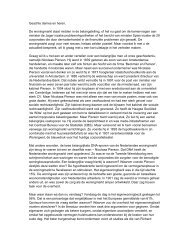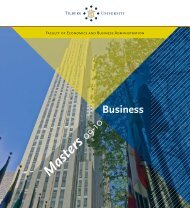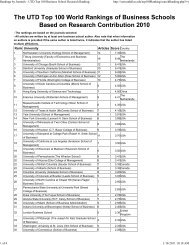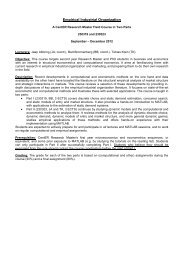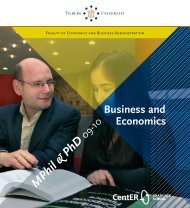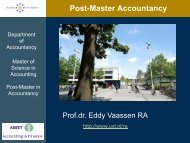Predicting the past - Tilburg University, The Netherlands
Predicting the past - Tilburg University, The Netherlands
Predicting the past - Tilburg University, The Netherlands
Create successful ePaper yourself
Turn your PDF publications into a flip-book with our unique Google optimized e-Paper software.
Sensitivity analysis<br />
All models are wrong but some are useful. In fact we can go one step fur<strong>the</strong>r. Even if we<br />
knew <strong>the</strong> truth, that is if we knew <strong>the</strong> model that actually generates <strong>the</strong> data, we would<br />
not want to use it. More precisely, if I tell you <strong>the</strong> correct functional form of <strong>the</strong> model<br />
(but not <strong>the</strong> values of <strong>the</strong> parameters), <strong>the</strong>n in general you should not use this model in<br />
estimation or forecasting.<br />
Isn’t that strange? <strong>The</strong> reason is as follows. If we delete a few variables from this large and<br />
complex, but true, model, <strong>the</strong>n a bias will occur in <strong>the</strong> estimates. If <strong>the</strong> variables that we<br />
exclude are relatively unimportant, <strong>the</strong>n <strong>the</strong> associated parameters will be close to zero,<br />
and <strong>the</strong> bias will be small. But, since we estimate fewer parameters, <strong>the</strong>ir precision will<br />
be better. Now, while <strong>the</strong> bias depends on <strong>the</strong> values of <strong>the</strong> parameters, <strong>the</strong> estimated<br />
variance does not. So, we can get a large reduction in variance even when <strong>the</strong> deleted<br />
parameters are close to zero. We will get better estimates using <strong>the</strong> smaller model. It is<br />
acceptable, even desirable, that <strong>the</strong> smaller model captures not everything, as long as it<br />
captures <strong>the</strong> essence. This is <strong>the</strong> art of modeling. As Einstein put it: ‘As simple as possible<br />
but not simpler.’<br />
After I came to <strong>Tilburg</strong> some twenty years ago, I became interested in sensitivity analysis,<br />
and I worked in this area with two PhD students: Anurag Banerjee and Andrey Vasnev. In<br />
sensitivity analysis we do not ask <strong>the</strong> question: is it true? Instead we ask: does it matter?<br />
A model is not true or false in this way of thinking, it is useful or not useful. And this<br />
depends on <strong>the</strong> question we wish to answer. A model can be useful when we wish to<br />
answer one question, but not when we wish to answer ano<strong>the</strong>r question. Sensitivity<br />
analysis thus breaks with <strong>the</strong> standard way of thinking that <strong>the</strong>re exists a truth which we<br />
need to approximate. Instead we now realize that this truth is not absolute and depends<br />
on <strong>the</strong> question that we ask.<br />
Sensitivity analysis works like this. Suppose we have one parameter of particular interest.<br />
We estimate this parameter using various models. <strong>The</strong>se models and <strong>the</strong> associated<br />
methods of estimation depend on assumptions. <strong>The</strong> estimate of <strong>the</strong> parameter may be<br />
sensitive or not sensitive to <strong>the</strong>se underlying assumptions. If it is sensitive to a specific<br />
assumption, <strong>the</strong>n we have apparently overlooked some essential aspect in <strong>the</strong> model. If it<br />
is not sensitive, <strong>the</strong>n this assumption is harmless.<br />
<strong>Predicting</strong> <strong>the</strong> <strong>past</strong> 13




